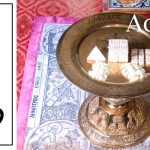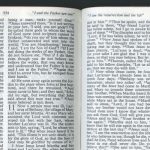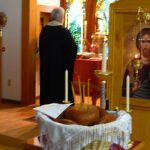
The Theology of Bread
Today, my beloved, our Church commemorates the miracle of our Lord Jesus Christ when He fed five-thousand men, not counting women and children, by multiplying five loaves of bread, as related to us by the evangelist Matthew. The evangelist John relates the same miracle and notes that the multitude who saw it were on the verge of proclaiming Jesus king, but because the disciples had already perceived the matter and had suffered a temptation, the Lord compelled His disciples to get into the boat and wait for Him on the other side of the lake while He dispersed the multitudes, precisely because He saw their desire to proclaim Him king.
The next day, the same multitude sought the Lord again. And when the Lord saw them, He said to them, Truly, truly, I say to you, you seek Me not because you have seen the miracle, but because you ate the loaves and were filled. I assure you that you do not seek Me because you saw a miracle, but because you ate bread and were filled (Jn. 6:26-27). Your motivation is, of course, superficial. Nevertheless, My Father gives you the true Bread, which is from Heaven, for the Bread that comes down from heaven is of God and gives life to the world (Jn. 6:33).
Therefore the Bread of God is He who comes down from Heaven and gives life to the world. I am the Bread of life; he that comes to Me will never hunger (Jn. 6:35). I am Jesus, the incarnate Son of God. I am the Bread of Life. We see, then, that the miracle of the multiplication of the loaves was an image of our reality. And of course the image was true since the miracle was real, but still an image, for this bread that was given to the people and which they ate, was a symbol of Jesus Christ, a symbol of His presence.
Moreover, my dear ones, bread has a deep theology, just as water also has a deep theology. It is well known that bread has always been considered a staple of all peoples. For precisely this reason, the entire world, all peoples, have always put bread under the protection of deities. Here in Greece, it is known that the ancient Greeks put bread under the protection of the goddess Demeter, along with all the crops of the earth that are produced for the nourishment of man, wheat being the most important. They were called “Demeter’s” precisely because they were put under the protection of the goddess Demeter.
For the Israelites also, bread was central in their life of worship. They had a special golden table which stood in front of the Ark of the Covenant and it represented the throne of God. On this table there were always twelve large loaves of bread in two rows and they were replaced every Sabbath. To say a little more about this, three priests retrieved four loaves each, while at the same time, another three priests brought in new loaves and placed them on this golden table. These twelve loaves remained there before the ark all week, before the presence of God. For this very reason these loaves were called “breads of presence”, because they were in the presence of God. It was an example, an expression of the people of Israel; there were twelve loaves because there were twelve tribes. It was also an expression of gratitude to God who furnishes, blesses, sanctifies and nourishes the universe.
In the New Testament, we see the Lord blessing bread in two of His miracles: the feeding of the five-thousand and the feeding of the four-thousand. The Lord also teaches us that we should seek from our Heavenly Father “our bread that is essential” (Mt 6:11, Lk. 11:3), that is, the bread that nourishes our essence, our existence. I want you to pay attention here, my dear ones, because behind this bread which is perceptible to the senses, we find the Bread of Life. This is precisely the theology of bread.
The Lord, if you like, was not only grieved, but said He “had compassion” for the multitude. He had compassion on the multitude that came seeking Him in the wilderness, and then said to His disciples for them to give them food to eat. That was not all. In one action of the Lord many purposes are accomplished. It was an occasion to “pique the interest” of these people, in order for them to say, “What are you talking about?” For them to seek bread and for the Lord to then tell them: This food is perishable; if you eat it you will hunger again and one day you will die. You will not always be able to eat; this bread is not able to sustain you in eternal life; but there is the Bread of Life, which, whoever eats it does not die in eternity. The reason, then, for the multiplication of loaves by the Lord was to prepare the people of God beforehand for the great teaching about the eating of the Bread of Life, which is the Lord Himself.
After this preparation (which was intended not only to prepare the multitude, but also to prepare His disciples, for some of them were scandalized and said, “He is going to give us His body to eat?” (Jn 6:52)) the Lord continues, turning to the disciples and says to them, Are you also scandalized? Do you also wish to leave? You can. What I have told you is true. And the Apostle Peter replies, “Lord, where could we go? You have the words of life.” (Jn. 6:68)
It was, indeed, a preparation beforehand, and for the disciples it was the final subject, the final exam of the subject, the sacrament of the Eucharist, when, on that monumental and historic night in the upper room in Jerusalem, the Lord offered His Body and Blood to His disciples for the forgiveness of their sins, for the world's and for the life of the world. So, my beloved, we see here the Lord engaging with the people of Capernaum and He says to them, with the disciples also listening: I am the Bread of Life who came down from heaven, the Living Bread. If any man eats of this Bread, he will live forever; and the Bread which I give is My flesh (Jn. 6:48-51), the Bread which I will give to whoever comes to Me and hungers is My flesh, which I give for the life of the world. He who eats My flesh and drinks My blood has eternal life; and I will raise him up on the last day” (Jn 6:54). This “I will raise him up on the last day” is repeated by the Lord three times, that is, he who communes will rise again. Of course, all human beings will resurrect, but the one who communes will be raised to eternal life. Do you see? When a man is about to depart from this present life and we want a priest to make it there on time to give him communion, it is on these words that our longing for a man to commune rests, since It is the eternal provision by which the Lord will resurrect him to eternal life on the last day. But understand this correctly. This is only the case, of course, when he accepts to receive Holy Communion willingly, and, of course, if he has gone to Confession.
What I will say now is a brief digression, but it must be said. There are many people who, unfortunately, do not want to receive Holy Communion, or, they accept to receive Holy Communion but do not go to Confession or repent. The sad thing is, we priests come up with tricks in order to make these people commune, like when we want little children to eat so they will not starve to death. Even worse, we resort to tricks to convince their relatives who are gathered around such dying persons, in order for them to let the priest commune their man. This, of course, is pitiful! If one goes and studies things deeply and reads about the life of the early Church, how the first Christians lived, how they longed for this holy Bread, the Body of Christ, you will discover that they not only made sacrifices, but even sacrificed their lives in order to partake of It in the catacombs, in order to participate in the Divine Liturgy of the Body and Blood of Christ. If one compares that golden age of the Church with the decadent age we live in, we will undoubtedly weep. Moreover, the Lord goes on to say, “He that eats My flesh abides in Me and I in him.” (John 6:53) O Man! You do not wish to receive Holy Communion because you think you are going to die? You will have eternal life! The Lord also says, “He who eats this Bread will live forever” (John 6:51). He will live forever. “For My Flesh is real food” (John 6:55) and because My Flesh is real food, it is eaten.
So, my beloved, this ordinary bread, that which we sow, harvest, grind, knead, bake and offer to the Church, does indeed nourish our physical existence, but this other bread, that which is literally transformed into the Body of Christ, is a mystery, and “mystery” means that you do not see it, but it is truly, literally, what the Lord said: It is My Body. Nothing less than what the Lord said: It is My Body. “This is My Body” (Mt. 26:26, Mk. 14:22, Lk. 22:19, cf. 1 Cor. 11:24)
For this reason, when we are going up to receive Holy Communion, we renew our faith at the last moment by reciting the prayer before receiving Holy Communion, “I believe that this is truly Your Body and that this is truly Your Blood.” We are saying, Yes, Lord, I still believe that this Bread is Your Body. I will repeat this reality once again because we must learn it well: This bread which is ordinary is transformed into the Body of Christ; and we commune not mere ordinary bread, but we commune, after the consecration, the Body of Christ. Thus, the Body of Christ becomes food for both body and soul and sustains man in eternal life, for he will indeed be raised to eternal life.
Since this Bread, then, is the Body of Christ, first of all, this bread itself constitutes the Church, for what is the Church but the Body of Christ? and what are the believers who partake of the Body of Christ but the Church itself? We can also say that the ordinary bread – not the Body of Christ, the ordinary bread – is a symbol of the Church. I repeat, not the consecrated bread, but the ordinary bread is a symbol of the Church.
In the ancient book, The Didachē, we find a blessing that refers to the Eucharist. In this blessing, the liturgist says: As that this which is broken (he has before him a piece of bread on the Holy Altar, before the consecration), once grew all over the hills and was gathered together when harvested, so too the Church is being gathered to You from the ends of the earth into the kingdom; as this bread was once wheat growing all over the hills and in the fields was reaped and formed into one bread, let Your Church in like manner, O Lord, be gathered together into Your kingdom. From this image you can see how ordinary bread came to be seen as a symbol of the Church, but the consecrated bread the essence of the Church. We find here the entire theology of the Church, for the center of worship is, precisely, to receive Holy Communion.
Why do we celebrate the Divine Liturgy? Why light candles? Why have a temple? Why offer incense? Why make prostrations? Why do we do all of these things? What do we have in the center? We have this bread, the Body of Christ, the holy Bread, the sanctified Bread. Do you understand this? What we have in the center of it all is our Lord. He is worshipped, He is adored. God alone is worshipped, and yet this holy Bread is also worshipped. Why? because it is truly the Body of Christ. Do you see? I keep talking on about this so that we may truly know what we are communing.
Even common, ordinary bread is an eschatological symbol of the unbroken union of believers with Christ in His Kingdom. There is a passage where someone was sitting at table with the Lord, someone who had heard the teaching of the Lord, whose heart rejoiced enthusiastically, and said, “Blessed is he who eats bread in the kingdom of God!” (Lk. 14:15) To say “bread” is the same as saying “meal”. Of course there will not be any bread in the kingdom of God, there will not be any food. We will not be eating. Food is but a symbol of the fellowship of the good things of the Kingdom of God. That is why, as I told you, it is an eschatological symbol. And yet, the Artoklasia service which we celebrate on feast days so often is nothing but a vestige of the “Agape meals” of the first Christians. We have preserved the memory of these Agape meals by celebrating the Artoklasia service and also by preserving the name the first Christians used for the Holy Eucharist.
Do you know what the Eucharist used to be called? The ancient name for the Eucharist was “Klasis”, meaning to break, “to break bread”. And we do not “break” with a knife (the verb would be “cut”), but I break with my hand, like when I have a loaf of bread in my hands and break it. This is why the priest does not use a sharp object, a knife, to cut the lamb on the Holy Altar, but breaks it with his hands, literally. He takes it in his hands and breaks it.
You see, we have preserved the ancient name and we have even preserved the manner of division, or rather the manner of distribution, for, in the early Church, the Holy Eucharist was distributed by the priest who broke the bread into pieces and, as the faithful passed by, he gave it to them. Next to the bread was the holy Cup and they partook of it from the Deacon or from a second priest. This is not the way it is done now since there are dangers. You see, technical reasons got in the way. With the artoklasia, however, what do we do? Here we cut and distribute the pieces. The Church has also kept this manner of distribution in the sacrament of the Holy Eucharist with the antidoron. And so, the Artoklasia service preserves the sacredness of bread.
While we are on the subject of artoklasia, allow me to say a few words about it. Saint Symeon of Thessalonica, it is known, has called the Artoklasia service “a tradition from on-high from the Savior himself”. The roots of this service can be traced back to when Christ blessed the bread in Emmaus (Lk. 24:30) and also the two times when He blessed the bread in the wilderness ((5,000) Mt. 14:14-21, Lk. 9:10-17, Jn. 6:1-15 | (4,000) Mt. 15:32-38, Mk. 8:1-9 ). This, then, is what we trace the Artoklasia service back to. We put five loaves of bread on a tetrapodion, that is, on a table – five loaves, not six or four – in remembrance of the miracle of the feeding of the five thousand. Moreover, my beloved, there is also wine and oil. A prayer is said in front of the artoklasia [sweet bread], in which the living are remembered – not the dead – asking that mercy, life, peace, health, salvation, the visitation of God, forgiveness and remission of sins be granted to them. This extensive prayer concludes, “Hear us, O God our Savior... Have mercy, have mercy on us, O Lord, on our sins and have mercy on us.” What do we ask for during the Artoklasia service? Forgiveness of our sins. We ask that our prayer may be received, through the intercessions of the Theotokos and of the Saints, so that our sins may be forgiven, so that protection from God may be given, so that every enemy both visible and invisible may be driven away, so that peace may be given in our lives, so that mercy may be shown to the world and so that we may be granted salvation. These are the things we ask for in this great prayer, with our heads bowed, humbly asking that they be granted to us, through the intercessions of the Theotokos and the Saints.
Then a hymn to the Theotokos is chanted, “Theotoke Parthene”. During this troparion, the artoklasia is censed crosswise, without any bowing on the part of the priest. While the priest censes the altar three times on each side, he makes a bow. Here we do not bow, simply because the bread is not consecrated, but it is about to be consecrated, or, if you like, blessed with the cross, the sign of the Cross, and with incense. The priest who blesses the bread represents Christ the Savior who blessed the five loaves in the wilderness. Moreover, “Theotoke Parthene” is chanted because the Theotokos is the mother of the Bread of Life. This, then, is why we cense the icon of the Virgin Mary afterwards. Then the following prayer is said: “O Lord Jesus Christ our God, who blessed the five loaves in the wilderness and with them fed five-thousand men, bless also these loaves, the wheat, the wine and the oil, and multiply them in this Holy Monastery (or this Church) and throughout Your world and sanctify Your faithful servants who partake of them.” What do we see here? A mention of the miracle: O You who fed the five-thousand and multiplied the loaves, bless also this bread and the other essential sustanances of life, this wine and oil, and, most importantly, bless and sanctify those who partake of them. Saint Symeon of Thessalonica, again, says that when we eat the pieces of bread which are distributed, gifts of health and many other gifts are given to those who partake of them with faith.
If you have faith you can receive gifts, you can become well and you can receive from God every other gift if you partake of this bread with faith. This explains why people run to get the artoklasia and are trampled on. But “why” we take this bread has become lost for us. Instead, we say, “Is this arto sweet?” or we take it so we can say “Yes, I got some arto!” It is hidden from these people that they are taking with them gifts from God. And the prayer concludes: “For You, O Christ our God, are the One who blesses and sanctifies the entire universe...” in order to show us that the giver of all good things is the Holy and Triune God. The chanting of “Wealthy people hungered and were impoverished, but those who are seeking to find the Lord, never will they be in want of any good thing” is a wonderful seal to this service, showing us that the only giver of good things is God, that those who seek Him will never go hungry and that those who trust in wealth will starve. My dearly beloved ones, the Psalmist says, “and bread to sustain the heart of man” (Ps. 103:15); by saying “heart” he means “existence”. When we eat bread which nourishes us, we should always recall the Bread of Life, Jesus Christ, because it is He, truly, Who is offered to the world in order to grant eternal life to the world. My beloved, the theology of bread opens our eyes to understand God’s wisdom and love for us.



